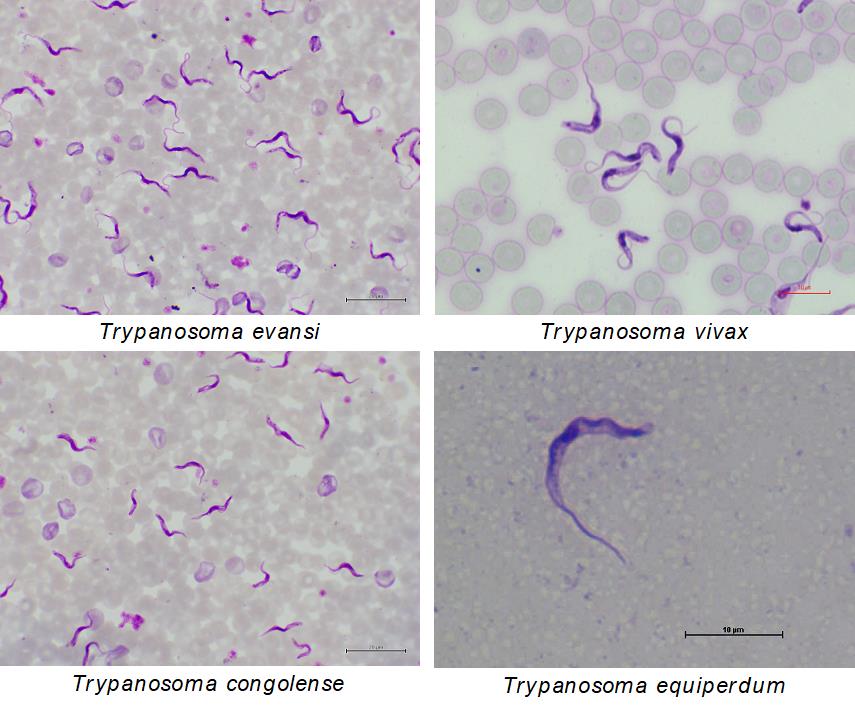Diagnostic Imagery
Trypanosoma vivax trypomastigotes in bovine Giemsa-stained blood smear—notice the slender bodies with undulating membranes visible among RBCs

Linear T. evansi trypomastigotes in stained bovine blood smear—useful in diagnosing “surra.”
General view showing prevalence of extracellular protozoa with clear kinetoplasts and flagella.

Overview and Epidemiology
Trypanosomiasis (nagana) in cattle is caused primarily by T. vivax, T. congolense, and T. brucei brucei, transmitted via tsetse flies (Glossina spp.) or mechanically by biting flies. It occurs widely in sub-Saharan Africa, parts of Latin America, and Asia. Prevalence in cattle can reach up to 22% based on PCR surveys (merckvetmanual.com, nature.com, researchgate.net, researchgate.net, freepik.com, en.wikipedia.org). Some African cattle breeds (e.g., N’Dama) display trypanotolerance—milder clinical signs despite parasitemia (en.wikipedia.org).
Clinical Signs
- Intermittent or continuous fever, lethargy, anorexia, progressive anemia, pale mucous membranes
- Edema, lymphadenopathy, reproductive failures (abortions, infertility)
- Severe infections may cause sudden death or neurological signs (cfsph.iastate.edu, vetlexicon.com)
Diagnostic Modalities
- Blood smear microscopy: Direct observation of extracellular trypanosomes—*
T. vivax* appear slender with anterior flagella; T. congolense and T. brucei have distinct shapes (cdc.gov, researchgate.net). - Buffy coat concentration (mini-Anion Exchange or QBC) raises diagnostic sensitivity (cdc.gov).
- PCR: Most sensitive for detecting low-level and carrier infections (researchgate.net).
- Serology (ELISA, CATT): Useful in epidemiological surveys but less so in acute disease (en.wikipedia.org).
Treatment and Supportive Care
- Trypanocides:
- Diminazene aceturate (3.5 mg/kg IM)
- Isometamidium prophylaxis and treatment
- Homidium bromide (less common) (merckvetmanual.com)
- Supportive therapy:
- NSAIDs (e.g., flunixin meglumine), IV fluids
- Blood transfusion for severe anemia
- Nutritional and stress support (cfsph.iastate.edu)
Prevention and Control
- Vector control: Acaricide-treated cattle, tsetse trapping, insecticide sprays on cattle (en.wikipedia.org).
- Chemoprophylaxis: Controlled periodic use of trypanocides in endemic herds.
- Breed selection: Use of trypanotolerant breeds like N’Dama in high-risk zones (en.wikipedia.org, en.wikipedia.org).
- Movement control and screening: Quarantine, treat or test introduced animals .
NAVLE-Style Multiple-Choice Questions
Q1: Diagnosis
A zebu steer in sub-Saharan Africa shows intermittent fever, progressive anemia, and pale mucous membranes. A buffy coat smear shows flagellated protozoa measuring ~15 µm with visible undulating membrane. What is the most likely diagnosis?
A. Anaplasmosis
B. Babesiosis
C. Trypanosomiasis (nagana)
D. Theileriosis
E. Leptospirosis
Correct Answer: C. Trypanosomiasis (nagana)
Explanation: Extracellular flagellated protozoa with undulating membrane are pathognomonic for Trypanosoma species (cdc.gov).
Q2: Treatment
A clinically positive heifer with T. vivax infection shows PCV of 16%. Swelling, lethargy, and fever persist. Ideal treatment strategy?
A. Oxytetracycline + transfusion
B. Imidocarb dipropionate + fluid support
C. Diminazene aceturate + NSAIDs
D. Pentamidine IM
E. Fexinidazole PO for 10 days
Correct Answer: C. Diminazene aceturate + NSAIDs
Explanation: Diminazene is effective trypanocide; supportive NSAIDs and fluids address systemic effects (en.wikipedia.org).
Q3: Prevention/Control
An outbreak of cattle trypanosomiasis follows seasonal grazing along bushy riverbanks. Which intervention is most effective before the next season?
A. Routine deworming
B. Breed switch to Holstein
C. Insecticide-treated cattle collars + treat positives
D. Vitamin-mineral supplementation
E. Monthly penicillin injections
Correct Answer: C. Insecticide-treated cattle collars + treat positives
Explanation: Vector control and targeted treatment reduce transmission in endemic grazing areas (en.wikipedia.org).
References
- Merck Veterinary Manual – Trypanosomiasis in Animals (merckvetmanual.com)
- CDC DPDx – African Trypanosomiasis Diagnosis (cdc.gov)
- CFS Prevention & Control – African Animal Trypanosomiasis (cfsph.iastate.edu)
- Senegal National Vet Records – N’Dama Trypanotolerance (en.wikipedia.org)
- FAO Field Guide – Diagnosis and trypanocide protocols (pmc.ncbi.nlm.nih.gov)